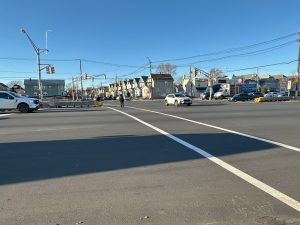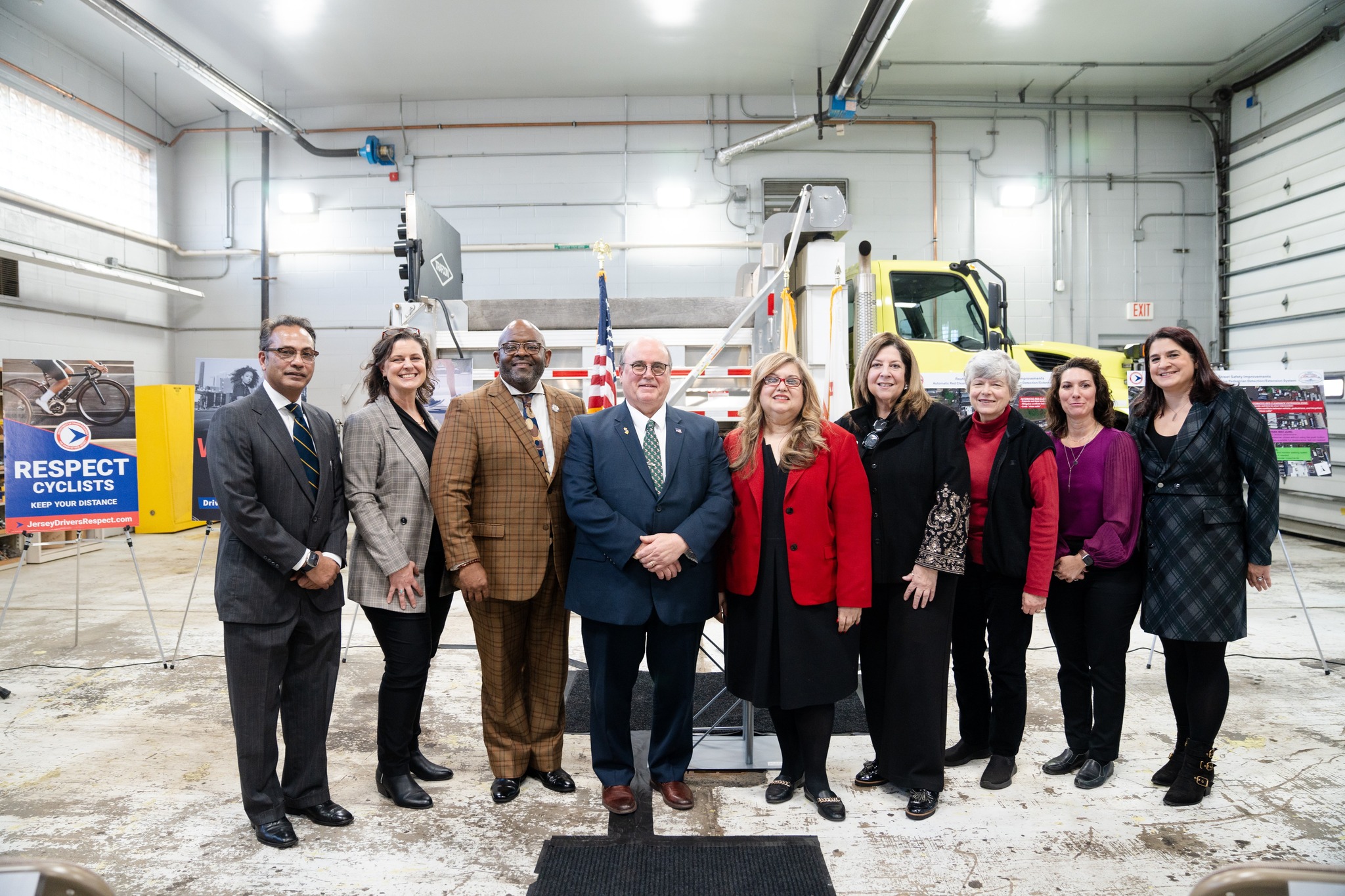On December 17, 2024, VTC Executive Director Leigh Ann Von Hagen joined NJ Department of Transportation Commissioner Frances O’Connor and other officials in Elizabeth, NJ, to announce new safety improvements along Route 1&9. The upgrades include the installation of Red-Light Extension and Passive Pedestrian Detection systems at the intersections of North Avenue, Fairmount Avenue, and East Jersey Street.
According to the NJDOT Media Advisory:
In early November 2024, NJDOT completed the installation of Red-Light Extension and Passive Pedestrian Detection systems at these intersections. These systems—first deployed on Route 129 in Trenton in 2022—have been shown to reduce crashes and fatalities involving both vehicles and pedestrians. The technology works by:
-
Red-Light Extension: Detecting a pedestrian in the crosswalk and extending the red light, giving the pedestrian more time to cross safely.
-
Passive Pedestrian Detection: Identifying a pedestrian approaching the crosswalk and automatically triggering the walk signal, eliminating the need to press a button.
NJDOT is recognized as a national leader in implementing Red-Light Extension technology. The Passive Pedestrian Detection system is now considered industry standard and is being deployed statewide.
See the NJDOT Media Advisory here.
Remarks by Leigh Ann Von Hagen:
Good afternoon, everyone.
Thank you for being here today. Your presence shows how much we all care about making our roads safer for everyone. My name is Leigh Ann Von Hagen, and I’m the newly appointed Executive Director of the Voorhees Transportation Center, housed within the Bloustein School of Planning and Public Policy at Rutgers University. For decades, our center has been a trusted resource for research and support on pedestrian and bicycle safety, especially through programs funded by the New Jersey Department of Transportation, such as the Bicycle, Pedestrian, and Safe Routes to School Resource Centers.
Today’s event is about hope and progress, but it also reminds us of the losses that make this work so important. Earlier this year, my family experienced a personal tragedy when my brother-in-law was struck and killed by a driver while walking across a road. That sudden and heartbreaking loss is something my family will carry forever. I know many families in New Jersey have faced similar tragedies, and my deepest condolences go out to all of you.
That pain is why we’re here today. It pushes us to not just talk about the challenges we face but to take real action to protect the most vulnerable people on our roads. Whether someone is walking, bicycling, using a wheelchair or assistive device, or riding an e-scooter or e-bike, every individual deserves roads that prioritize their safety and dignity. Sadly, this year our pedestrian fatalities are higher than they’ve been and are still rising, including losing two school crossing guards within the last few weeks—guards who died while crossing children on their way to school. We cannot use the same strategies and expect improved outcomes.

Routes 1 and 9 in Elizabeth, NJ
The three intersections along Routes 1 and 9 that we’re highlighting today—North Avenue, Fairmount Avenue, and East Jersey Street—are examples of the kind of innovative strategies and changes that need to happen across New Jersey and the nation. Adding Red-Light Extension and Passive Pedestrian systems at these locations is a step forward in creating roads that work for everyone—not just cars and trucks. Through our research at Rutgers, we have seen how well-designed, data-driven solutions like these can significantly reduce crashes and save lives.
At the Voorhees Transportation Center, my team and I focus on ways to make walking and bicycling safer for people of all ages and abilities. We emphasize the importance of Complete Streets implementation, which aims to serve the needs of all road users, including those with disabilities. Through our New Jersey Department of Transportation-funded programs, we provide training and education to communities across the state, equipping them to implement Complete Street policies and infrastructure effectively. I applaud the New Jersey Department of Transportation for their leadership in recently updating their guidelines that integrate Complete Streets practices into all New Jersey Department of Transportation projects—a major step forward in making our roads safer and more inclusive. Complete Streets are about designing roads to meet the needs of everyone who uses them, and I commend the NJDOT for taking the lead in promoting these practices.
Working together—researchers, community leaders, and agencies like NJDOT—is how we make real progress. The Federal Highway Administration has called for a new way of thinking about traffic safety, one that starts with the goal of eliminating deaths and serious injuries on our roads. This vision, shared by NJDOT and the Vision Zero communities across the state, is rooted in the Safe System Approach, which focuses on constantly improving road design to protect people from harm. With the Safe System Approach, redundancy is critical. This approach emphasizes building and reinforcing multiple layers of protection to both prevent crashes from happening and minimize the harm caused when they do occur. By incorporating redundancy, we create a more resilient and forgiving road system that can better accommodate human errors and vulnerabilities.
I applaud the New Jersey Department of Transportation for embracing innovative solutions and advanced technology. It’s not always easy to try new ideas, but it’s essential if we want to make our roads safer. Progress in road safety requires constant learning, refining, and advancing, guided by a commitment to testing, monitoring, and evaluating what works.
Thank you to the New Jersey Department of Transportation for inviting me to speak today, for supporting our research at the Voorhees Transportation Center, and for your leadership in creating a safer, more sustainable future for our state. Today’s improvements demonstrate that commitment.
Please join me in welcoming Commissioner Fran O’Connor back to the podium.
Other press coverage of the event:
NJDOT and local officials to announce Route 1&9 intersection safety improvements in Elizabeth. TapInto Elizabeth. December 7, 2024.
Higgs, L. These dangerous N.J. intersections are getting new tech to make them safer for pedestrians. NJ.com. December 18, 2024.
Keating, C. New cameras installed to enhance pedestrian safety on Route 1 & 9 in Elizabeth. News12 New Jersey. December 17, 2024.
